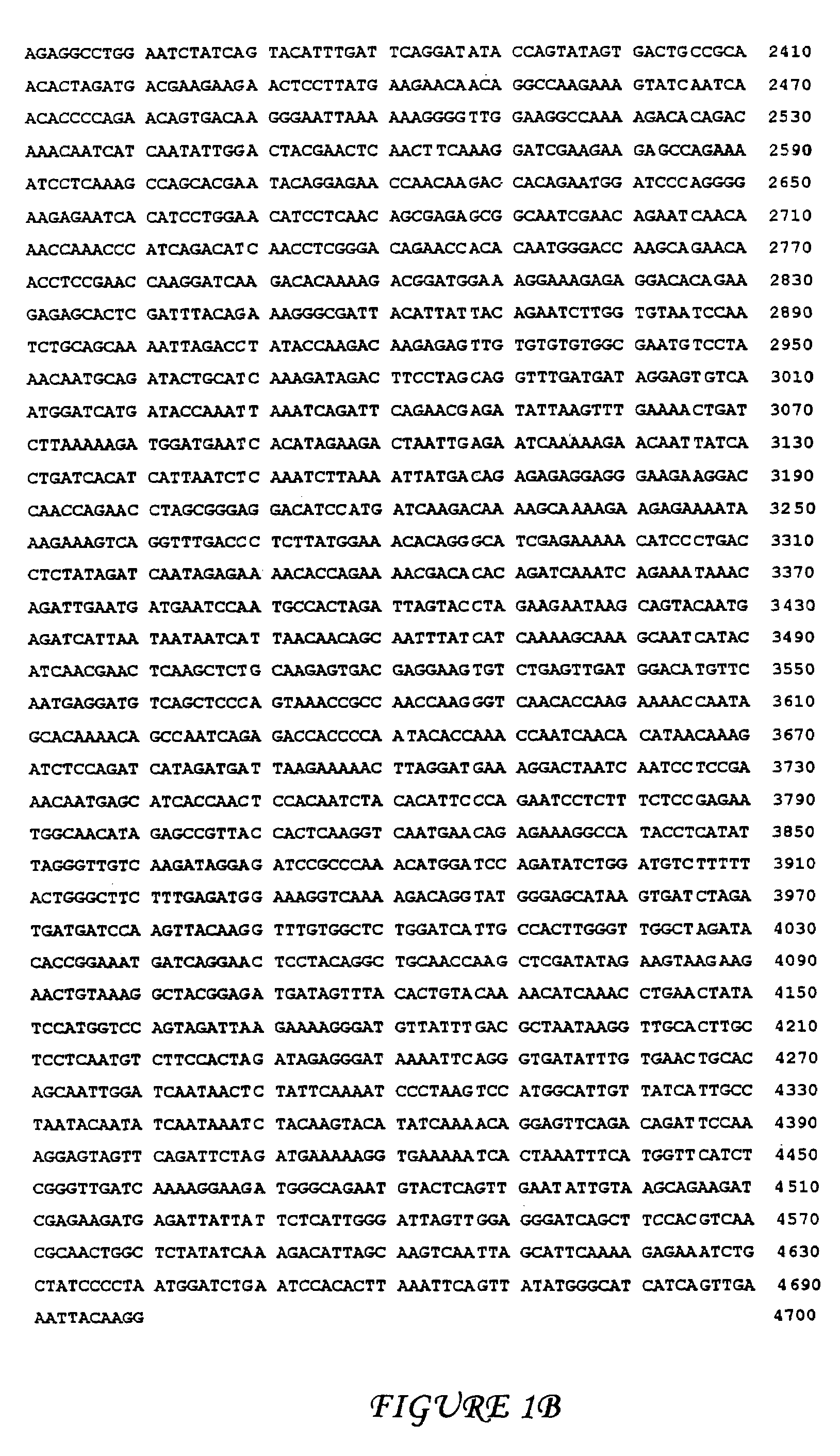Attenuated human-bovine chimeric parainfluenza virus (PIV) vaccines
a vaccine technology, applied in the field of attenuated human-bovine chimeric parainfluenza virus (piv) vaccines, can solve the problems of no approved vaccine agent, no proven method for adjusting the level of attenuation, and less than in children's substantial morbidity
- Summary
- Abstract
- Description
- Claims
- Application Information
AI Technical Summary
Benefits of technology
Problems solved by technology
Method used
Image
Examples
example i
Construction of cDNAs Encoding a Chimeric HPIV3 / BPIV3 Antigenome and Recovery of Infectious Virus
[0195]The following three examples document studies to identify which of the proteins of BPIV3 contribute to its host range restriction in primates. To illustrate these methods, the N protein of the wild type HPIV3 virus was replaced with its counterpart from BPIV3. This exchange was accomplished using a reverse genetics system for recovery of infectious PIV from cDNA as described above. The studies were initiated with the N gene of BPIV3 because this protein possesses an intermediate level of amino acid sequence difference from its HPIV3 counterpart compared to other HPIV3 and BPIV3 proteins (see Example I).
[0196]A chimeric recombinant virus was constructed in which the N ORF of the JS strain of HPIV3 was replaced by that of either the Ka or SF strain of BPIV3. These chimeric viruses possess the HN and F glycoproteins of the HPIV3 parent and will induce a high level of immunity to HPIV3...
example ii
Replication of HPIV3 / BPIV3 Chimeric Viruses in Cell Culture
[0205]Efficient replication of live attenuated virus vaccines in tissue culture cells is a feature of human-bovine chimeric PIV of the invention that permits efficient manufacture of the recombinant vaccine materials. The multicycle replication of rJS parent, cKa, Ka parent, cSF, and SF parent in a bovine cell line (MDBK) and in a simian cell line (LLC-MK2) was determined by infecting cells with virus at a multiplicity of infection of 0.01 and harvesting samples (in triplicate) over a five day period of time (FIG. 7) as previously described (Tao et al., 1998, supra, incorporated herein by reference). The chimeric viruses replicated efficiently in both cell lines like their human or bovine parent viruses without significant delay in replication or a significant reduction in the titer of virus achieved. In each case, the chimeric viruses replicated to over 107.0 TCID50 ml which is well above the 104.0 or 105.0 dose of live att...
example iii
Evaluation of Attenuation and Protective Efficacy of the HPIV3 / BPIV3 Chimeric Viruses in Rhesus Monkeys
[0206]Both the SF and Ka BPIV3s are attenuated for the upper and the lower respiratory tract of the rhesus monkey (van Wyke Coelingh et al., 1988, supra). This attenuation phenotype correlates with attenuation in humans (Karron et al., 1995a, supra) as indicated by the fact that Ka is highly restricted in replication in the upper respiratory tract of fully susceptible seronegative infants and children. The absence of cough, croup, bronchiolitis, or pneumonia in the BPIV3-infected vaccinees suggests that the Ka BPIV3 virus is attenuated for the lower respiratory tract as well. Therefore, the rhesus monkey is widely accepted as a reasonably correlative model to evaluate attenuation of candidate PIV vaccine viruses and their efficacy against challenge with wild type PIV.
[0207]The rJS, cKa, Ka parent, cSF, and SF parent were administered intranasally and intratracheally at a dose of 10...
PUM
| Property | Measurement | Unit |
|---|---|---|
| time | aaaaa | aaaaa |
| genetic stability | aaaaa | aaaaa |
| temperature-sensitivity | aaaaa | aaaaa |
Abstract
Description
Claims
Application Information
 Login to View More
Login to View More - R&D
- Intellectual Property
- Life Sciences
- Materials
- Tech Scout
- Unparalleled Data Quality
- Higher Quality Content
- 60% Fewer Hallucinations
Browse by: Latest US Patents, China's latest patents, Technical Efficacy Thesaurus, Application Domain, Technology Topic, Popular Technical Reports.
© 2025 PatSnap. All rights reserved.Legal|Privacy policy|Modern Slavery Act Transparency Statement|Sitemap|About US| Contact US: help@patsnap.com



